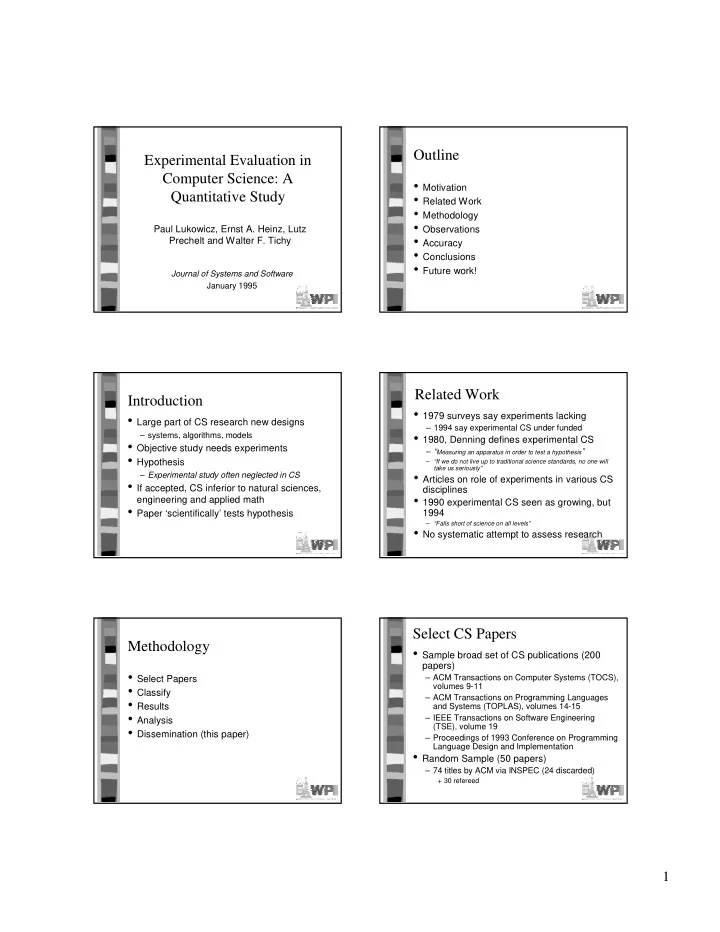

Outline Experimental Evaluation in Computer Science: A • Motivation Quantitative Study • Related Work • Methodology • Observations Paul Lukowicz, Ernst A. Heinz, Lutz • Accuracy Prechelt and Walter F. Tichy • Conclusions • Future work! Journal of Systems and Software January 1995 Related Work Introduction • 1979 surveys say experiments lacking • Large part of CS research new designs – 1994 say experimental CS under funded – systems, algorithms, models • 1980, Denning defines experimental CS • Objective study needs experiments – “ Measuring an apparatus in order to test a hypothesis ” • Hypothesis – “If we do not live up to traditional science standards, no one will take us seriously” – Experimental study often neglected in CS • Articles on role of experiments in various CS • If accepted, CS inferior to natural sciences, disciplines • 1990 experimental CS seen as growing, but engineering and applied math • Paper ‘scientifically’ tests hypothesis 1994 – “Falls short of science on all levels” • No systematic attempt to assess research Select CS Papers Methodology • Sample broad set of CS publications (200 papers) • Select Papers – ACM Transactions on Computer Systems (TOCS), volumes 9-11 • Classify – ACM Transactions on Programming Languages • Results and Systems (TOPLAS), volumes 14-15 • Analysis – IEEE Transactions on Software Engineering (TSE), volume 19 • Dissemination (this paper) – Proceedings of 1993 Conference on Programming Language Design and Implementation • Random Sample (50 papers) – 74 titles by ACM via INSPEC (24 discarded) + 30 refereed 1
Select Comparison Papers Classify • Neural Computing (72 papers) – Neural Computation, volume 5 – Interdsciplinary: bio, CS, math, medicine … – Neural networks, neural modeling … – Young field (1990) and CS overlap • Optical Engineering (75 papers) – Optical Engineering, volume 33, no 1 and 3 – Applied optics, opto-mech, image proc. • Same person read most – Contributors from: ee, astronomy, optics… – Applied, like CS, but longer history • Two read all, save NC Subclasses of Design and Major Categories Modeling • Formal Theory • Amount of physical space for experiments – Formally tractable: theorem’s and proofs – Setups, Results, Analysis • Design and Modeling • 0-10%, 11-20%, 21-50%, 51%+ • To shallow? Assumptions: – Systems, techniques, models – Cannot be formally proven ! require experiments – Amount of space proportional to importance by • Empirical Work authors and reviewers – Amount of space correlated to importance to – Analyze performance of known objects • Hypothesis Testing research • Also, concerned with those that had no – Describe hypotheses and test experimental evaluation at all • Other – Ex: surveys Assessing Experimental Outline Evaluation • Look for execution of apparatus, techniques or methods, models validated • Motivation • Tables, graphs, section headings… • Related Work • No assessment of quality • Methodology • But count only ‘true’ experimental work • Observations – Repeatable • Accuracy – Objective (ex: benchmark) • No demonstrations, no examples • Conclusions • Future work! • Some simulations – Supplies data for other experiments – Trace driven 2
Observation of Major Categories Observation of Major Categories • Majority is design and modeling • The CS samples have lower percentage of empirical work than OE and NC • Hypothesis testing is rare (4 articles out of 403!) • Combine hypothesis testing with empirical Observation of Design Sub- Observation of Design Sub- Classes Classes • Higher percentage with no evaluation for CS • Many more NC+OE with 20%+ than in CS vs. NC+OE (43% vs. 14%) • Software engineering (TSE and TOPLAS) worse than random Groupwork: How Experimental is Observation of Design Sub- WPI CS? Classes • Take 2 papers: KDDRG, PEDS, SERG, DSRG, AIDG, GTRG • Read abstract, flip through • Categorize: – Formal Theory – Design and Modelling + Count pages for experiments – Empirical – Hypothesis Testing – Other • Shows percentage that have 20%+ or more • Swap with another group to experimental evaluation 3
Outline Accuracy of Study • Deals with humans, so subjective • Psychology techniques to get objective • Motivation • Related Work measure • Methodology – Large number of users ! Beyond resources (and a lot of work!) • Observations – Provide papers, so other can provide data • Accuracy • Conclusions • Systematic errors • Future work – Classification errors – Paper selection bias Systematic Error: Classification Systematic Error: Classification • Classification ambiguity – Large between Theory and Design-0% (26%) – Design-0% and Other (10%) – Design-0% with simulations (20%) • Counting inaccuracy – 15% from counting experiment space differently • Classification differences between 468 article classification pairs Overall Accuracy (Maximize Distortion) Systematic Error: Paper Selection No Experimental • Journals may not be representative of CS Evaluation – PLDI proceedings is a ‘case study’ of conferences • Random sample may not be “random” – Influenced by INSPEC database holdings – Further influenced by library holdings • Statistical error if selection within journals do 20%+ Space for not represent journals Experiments 4
Conclusion Guidelines • 40% of CS design articles lack experiments • Higher standards for design papers – Non-CS around 10% • Recognize empirical as first class science • 70% of CS have less than 20% space • Need more publicly available benchmarks – NC and OE around 40% • Need rules for how to conduct repeatable • CS conferences no worse than journals! experiments • Youth of CS is not to blame • Tenure committees and funding orgs need to • Experiment difficulty not to blame recognize work involved in experimental CS • Look in the mirror – Harder in physics – Psychology methods can help • Field as a whole neglects importance 5
Recommend
More recommend